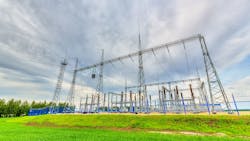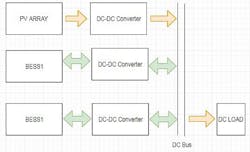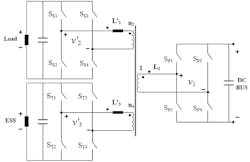High-Power-Density DC-DC Converters in DC Microgrids
This article is part of the Power Management Series: Delving Into Power Density
Members can download this article in PDF format.
What you'll learn:
- What is a dc microgrid?
- Different power electronic converter architectures used for microgrids.
Microgrids are essentially a network of loads and local power generations (distributed generations), along with energy storage systems.
The most efficient way to increase the use of renewable-energy sources, such as solar, wind, water, and various forms of biomass, is to make use of renewable energy systems in smart cities, villages, townships, etc., that have reasonably large populations of energy consumers.
This article will focus on high-power-density dc-dc converter architectures for dc microgrids. A variety of energy sources employed by dc microgrids need energy-storage systems (ESS) to stabilize grid systems. Figure 1 shows a single photovoltaic (PV) generator with two battery energy-storage systems (BESSs) and a dc load. The distributed energy storage units (DESUs) are BESSs that have bidirectional converters with the ability to discharge and charge. The multiple-BESS architecture is preferred for reliability and redundancy in case of damage.
The direct-current (dc) microgrid is an important subject of late since it has high reliability and low losses, and it distributes dc power needed by loads on a campus. Power generation in dc microgrid systems can be ac or dc; however, in most cases ac power supplies are converted to dc for distribution. One key advantage of dc microgrids, as compared to ac systems, is the use of a unidirectional power flow. Power control in these dc systems are easily controlled by the power-flow direction.
Let’s take a look at some power electronic converter (PEC) architectures for dc microgrids.1
Single-Phase, Non-Isolated, Bidirectional DC-DC Converters
Our first option is bidirectional dc-dc converters, which are able to interface BESSs with the dc bus. We will examine non-isolated bidirectional dc-dc converters that are employed when galvanic isolation and high-step-up or step-down of voltage isn’t required, such as in isolated converters. The choice for this case is the buck-boost (half-bridge), which will enable power flow in and out of the BESS. The bidirectional half-bridge is the most used architecture in dc microgrid applications.
The table presents a comparative study of single-phase bidirectional non-isolated converters. The summarized results, under discharging operation only, are for four types of these converters: buck-boost half-bridge, cascaded buck-boost, buck-boost with tapped inductor, and SEPIC.
In summary, the bidirectional cascaded buck-boost (CBB) converter had a higher discharge current as compared to a conventional half-bridge. It also has four quadrants as compared to the half-bridge, which has only two quadrants. This deems the CBB a better suited power solution for higher power applications as well as applications needing energy sharing among distributed users based on load demand.
Among all types of dc–dc converters, the bidirectional CBB converter will typically achieve the highest efficiency due to its low voltage and smaller current stresses. It’s the key to interconnecting the dc sources and energy-storage components as well as managing the power flow. These features lead to high power density.
Dual-Active-Bridge (DAB) DC-DC Converter
The DAB converter is widely used in dc grid designs.2 The advantages of this architecture are high power density, electrical isolation, bidirectional energy flow, and simple soft-switching control. This architecture acts as a power electronic interface between the ESS and the dc bus in addition to bidirectional flow of power between the energy components and the dc bus.
The DAB converter is able to convert electrical energy at high frequency through a two-stage structure of dc-ac and then ac-dc. The topology of a DAB converter is shown in Figure 2.
The topology is composed of a high frequency transformer (T) with a voltage ratio of 1:n, an inductance (Lb), along with active full bridges on the primary and secondary sides on the transformer. The primary-side full bridge connects to a storage battery through an LC filter, and the secondary side is connected to the dc bus. The power of a DAB converter is transmitted through inductor Lb in Figure 2.
Let’s now look at the control strategy of a virtual dc machine (VDCM) for the converter interface to suppress the voltage dip of the dc bus and improve the power quality. When the new energy changes suddenly, it triggers load switching and disturbance of the large power grid. A dc voltage dip is caused by the sudden change in micro-source power, load switching, and ac grid disturbance in the dc microgrid.
Applying the VDCM control in the DAB converter changes the external characteristics of the ESS and enables it to have the inertia characteristics of a dc machine. This technique leads to a much improved droop, with the use of a dc machine, over traditional droop control methods (Fig. 3).
The front port U1 and I1 are connected to the dc output terminal of the battery, and the back end U2 and I2 are linked to the common dc bus:
In the equation, H denotes the inertia time constant in a dc machine, ξ is the damping coefficient, ω and ω0 are the mechanical angular velocity and rated value of the dc motor, respectively, and Tm and Te are the mechanical and electromagnetic torque, respectively.
Virtual synchronous generator (VSG) control is used in ac interfaces to simulate the characteristics of a synchronous motor, and the dc interfaces use VDCM control to mimic the dc machine’s characteristics. This effectively enhances the inertia and damping of the energy router.
To summarize, we’ve looked at the problem of a dc voltage dip that’s caused by a quick change in micro-source power, load switching, and ac grid disturbance in a dc microgrid. VDCM is proposed here to simulate the inertia characteristics of a dc machine. We use a DAB dc-dc converter as the application scenario. This converter has many advantages for electrical isolation, high power density, bidirectional flow of energy, and easy realization of soft-switching control. Simulations have shown that VDCM is able to effectively suppress voltage fluctuations, reduce voltage dip amplitude, and improve voltage quality. High power density is achieved with this method.
Bidirectional Three-Port DC-DC Converter for Battery Apps in DC Microgrids
The triple-active-bridge (TAB) converter has the advantages of galvanic isolation, bidirectional power transfer, and low number of components.3
Conventional TAB converters require power decoupling control to remove power correlation between ports, which adds complexity to the system design. Moreover, it induces circulating current in the ESS port even when not used, which will decrease the total power-conversion efficiency.
A solution to these problems is the isolated bidirectional three-port dc-dc converter, which has high power density, the absence of the need for a power decoupling control, and low circulating current in the ESS port (Fig. 4).
So, in summary, the bidirectional three-port dc-dc converter, discussed above, has the following advantages:
- High power density and low cost because there’s one less inductor than a conventional TAB converter.
- Less circulating current in the energy-storage port when it’s not being used.
- Simple control as compared to the conventional TAB converter, which would need more inductors and an additional decoupling control algorithm.
Conclusion
The dc microgrid is an excellent system that interconnects dc output sources and supplies high-quality power dc microgrids that use many different types of energy sources. These sources need ESS to stabilize power-grid systems. This article has shown some advantages of using different dc-dc converter architectures that contribute significantly to high-power-density improvements for dc microgrids.
References
1. “A Comparative Study of Single-phase Non-isolated Bidirectional dc-dc Converters Suitability for Energy Storage Application in a dc Microgrid,” Polycarp Odo, 2020 IEEE.
2. “A Virtual DC Machine Control Strategy for Dual Active Bridge DC-DC Converter,” Yu Guo, Jianhui Meng, Yi Wang, Chen Wang, 2019 IEEE PES Innovative Smart Grid Technologies Asia.
3 “High Power Density Bidirectional Three-port DC-DC Converter for Battery Applications in DC microgrids,” Juyoung Sim, Junyoung Lee, Hyunjun Choi and Jee-Hoon Jung.






